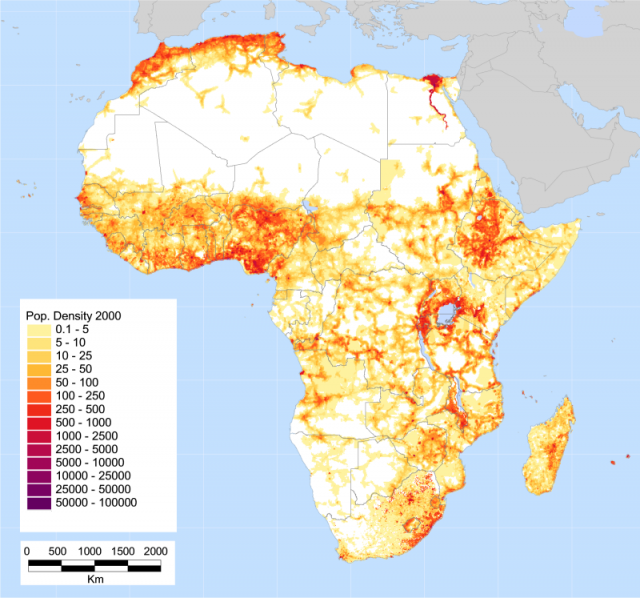Population
Africa's population is growing at a faster rate than that of any other region of the world. According to the International Data Base of the U.S. Bureau of the Census, the estimated population of the continent in 2001 was 823.2 million people. The same organization projects that by the year 2050 Africa will have 1.8 billion people—perhaps 20 percent of the world's population.
Information about population figures and trends is of vital importance in determining how to use resources and plan for the future. Demographers, the researchers who study population data, are interested in more than just the number of people living in a particular country or region. They also want information about the age and gender of the population, the number of children born to each woman, and the number of deaths each year. These factors help them predict how the population will change in the coming years. For a number of reasons, population data is less certain for Africa, especially sub-Saharan Africa, than for any other major world region. Demographers know, however, that sub-Saharan Africa has the world's highest birth, death, and population growth rates.

Gathering Population Data
No reliable information about Africa's overall population existed before the 1900s. Colonial officials in Britishadministered colonies such as EGYPT and SIERRA LEONE did begin taking censuses—systematic counts of the population—in the late 1800s, and by the mid-1900s other colonial administrations were carrying out censuses as well. The concept of counting people and keeping records was new to Africans, and census takers had to devise methods that people could easily use. Some of the early solutions were creative, such as having villages send gourds containing a bean for each man, a nut for each woman, and a stone for each child who lived in the village.
Beginning in the 1950s, censuses took on new importance for development planning. They also had a role in the independence movement because officials often used census data to prepare lists of voters. The new censuses were more reliable than earlier ones, partly because of the greater number of educated Africans, especially schoolteachers, who could serve as census takers. The UNITED NATIONS became involved in 1971 with the establishment of the African Census Program, which has held at least one census in every African nation.
Despite improvements in census taking, problems remain. Many Africans have been reluctant to provide information, generally because they fear being identified for tax purposes. Counters have sometimes inflated the numbers for some groups because of ethnic or political rivalries or because the distribution of promised resources is based on population counts.
Recording people's ages is another problem. In many African cultures, people do not reckon their age in years. Instead, they consider themselves part of an age-set, a group of individuals who are about the same age. Demographers cannot obtain more precise information from official records because no African nation has a completely effective system for recording the births and deaths of all citizens.
Current Information and Trends
The rapid rate of Africa's population growth is due to two main factors. One is mortality—the number of deaths in a given time or place. Africa's mortality rate has fallen for the past 100 years. In general, this means that more people are living longer, although mortality rates are uneven across the continent. A person born in sub-Saharan Africa today can expect to live an average of 49 years, while in North Africa the life expectancy is 68 years. Infant mortality—the number of infants who die in the first year of life—is also higher in sub-Saharan Africa than in North Africa.
The second factor is the birth or fertility rate, based on the average number of children a woman bears in her lifetime. Like the mortality rate, the fertility rate varies across Africa. North Africa's fertility rate has fallen somewhat to an average of four children per woman, while in sub-Saharan Africa the fertility rate has remained fairly steady at nearly sixchildren per woman, the highest in the world. Reasons for North Africa's birthrate decline include greater ease of divorce, marriage at later ages, and increased educational and job opportunities for women. Demographers expect that as such trends become stronger in sub-Saharan Africa, the birthrate will fall there also.
Overall, Africa's is an extremely young population. In most of the continent, more than 40 percent of the population is under 15 years of age. This high percentage of children and young adolescents means that even if each young woman bears fewer children than her mother or grandmother did, Africa's population will keep growing at a high rate for some time. (See also Age and Aging, AIDS, Diseases, Health Care, Hunger and Famine, Warfare.)